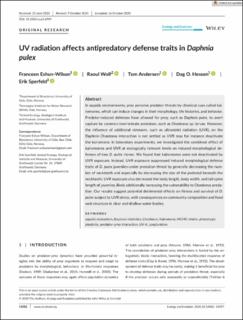| dc.description.abstract | In aquatic environments, prey perceive predator threats by chemical cues called kairomones, which can induce changes in their morphology, life histories, and behavior. Predator‐induced defenses have allowed for prey, such as Daphnia pulex, to avert capture by common invertebrate predators, such as Chaoborus sp. larvae. However, the influence of additional stressors, such as ultraviolet radiation (UVR), on the Daphnia–Chaoborus interaction is not settled as UVR may for instance deactivate the kairomone. In laboratory experiments, we investigated the combined effect of kairomones and UVR at ecologically relevant levels on induced morphological defenses of two D. pulex clones. We found that kairomones were not deactivated by UVR exposure. Instead, UVR exposure suppressed induced morphological defense traits of D. pulex juveniles under predation threat by generally decreasing the number of neckteeth and especially by decreasing the size of the pedestal beneath the neckteeth. UVR exposure also decreased the body length, body width, and tail spine length of juveniles, likely additionally increasing the vulnerability to Chaoborus predation. Our results suggest potential detrimental effects on fitness and survival of D. pulex subject to UVR stress, with consequences on community composition and food web structure in clear and shallow water bodies. | en_US |

